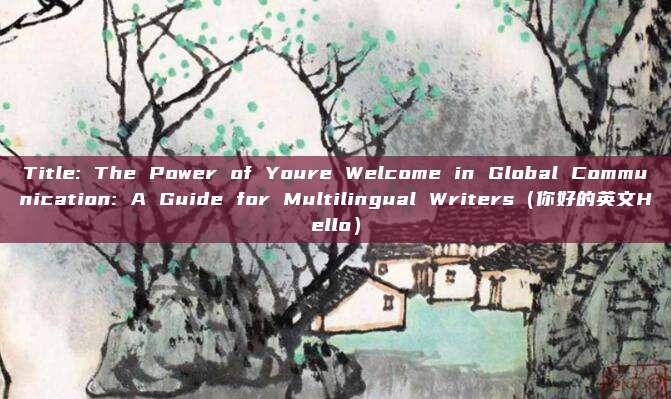Title: The Power of Youre Welcome in Global Communication: A Guide for Multilingual Writers(你好的英文Hello)
温馨提示:这篇文章已超过231天没有更新,请注意相关的内容是否还可用!
Content:
In the vast world of communication, the art of saying "you're welcome" transcends languages and cultures. As a multilingual writer, understanding the nuances and appropriate usage of "you're welcome" and its equivalents can greatly enhance your global reach and audience engagement. This article delves into the significance of "you're welcome" across different languages, its cultural implications, and practical tips for incorporating it effectively in your writing.
Introduction:
"Thank you" is a universally appreciated expression of gratitude. However, the response to a thank you can vary widely depending on the culture and language. "You're welcome" is the English equivalent, but what about other languages? How do you say "you're welcome" in Spanish, French, German, or Mandarin? This article explores these variations and offers insights into the cultural significance of these expressions.

The English "You're Welcome":
In English, "you're welcome" is a friendly and polite response to a thank you. It's a way of showing that you're pleased to have been helpful. While it might seem simple, there are subtle differences in how "you're welcome" can be expressed depending on the context:
Formal Setting: In formal situations, "you're welcome" is typically followed by "my pleasure" or simply “not at all.”
Informal Setting: In casual conversations, "no problem," "anytime," or even "you're welcome!" can be used interchangeably.
Cultural Variations:
The equivalent expressions of "you're welcome" vary greatly across cultures. Here are some common examples:
Spanish: "De nada" or "no hay problema."
French: "De rien" or "rien de grave."
German: "Kein Problem" or "gerne geschehen."
Mandarin: "Bu qing" (不客气) or "ni hao" (没关系).
Each of these expressions carries a similar sentiment but is tailored to the cultural nuances of the language.
Practical Tips for Multilingual Writers:
1、Understand Cultural Differences: Before using "you're welcome" in a different language, research the cultural context to ensure it's appropriate.
2、Use Local Expressions: When writing for a specific audience, consider using the local equivalent of "you're welcome" to enhance relatability.
3、Be Consistent: Maintain consistency in your choice of expressions across your writing to maintain a professional tone.
4、Consider Context: The context of the interaction can influence the choice of expression. A casual conversation might warrant a more relaxed response than a formal business email.
Conclusion:
The expression "you're welcome" may seem trivial, but it plays a crucial role in global communication. As a multilingual writer, understanding and using the appropriate expressions in different languages can significantly enhance your work's impact and reach. By being aware of cultural nuances and practical considerations, you can ensure that your writing resonates with audiences worldwide.
References:
- "Cultural Etiquette: The Art of Saying 'Thank You' Around the World." The Culture Mastery, 2021.
- "The Complete Guide to Saying 'Thank You' in Different Languages." FluentU, 2020.
- "The Power of Language: How Cultural Nuances Affect Communication." The Globalist, 2019.
网站文章、图片来源于网络,以不营利的目的分享经验知识,版权归原作者所有。如有侵权请联系删除!





还没有评论,来说两句吧...